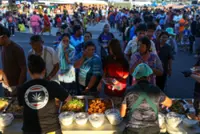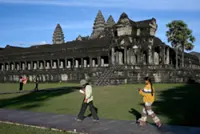Visitors enjoying paddling boats around the Stung Treng Ramsar site. - Phnom Penh Post/ANN
PHNOM PENH (Phnom Penh Post/ANN): Nestled in the northern reaches of the Mekong River in Stung Treng province lies the Stung Treng Ramsar site, a bastion of biodiversity and a beacon for eco-tourists.
Spanning over 1,460ha, this wetland haven forms a mosaic of habitats, hosting a plethora of species from kingfishers to elusive Irrawaddy dolphins.
As the Mekong’s waters draw back with the dry season, a landscape once submerged is unveiled. It’s time paddlers weave through the wetland’s tapestry, guided by the exposed roots of trees.
Sandy isles materialise, offering tranquil campsites under the cosmos – a setting where, according to Kim Poleak, a former tour guide turned insurance professional, the galaxies unfurl in the night sky’s embrace.
Poleak’s affinity with the site is profound. His tenure as a guide has rendered intimate knowledge of the region’s natural wealth.
“The community’s commitment to traditional fishing harmonises with the wetland’s life,” he shares, reflecting on the symbiosis of man and nature.
The Stung Treng Ramsar site boasts an array of islands such as Koh Han and Koh Thmor Komboul, each a unique testament to the region’s allure.
Here, tourism isn’t merely an industry; it’s a lifeline, weaving through the community fabric, supplementing fishing incomes and fostering conservation.
“The uniqueness of the Stung Treng Ramsar site lies in its biodiversity, supporting community livelihoods and adding to family income through tourism. The intriguing aspect is the protection and conservation of this special place,” he explains.
He adds that in Cambodia, there are five Ramsar sites: Stung Treng, Tonle Chhmar Lake, Koh Kapi, Stung Sen and Prek Toal.
Nature’s symphony
Poleak says the Stung Treng Ramsar site is different from the other Ramsar wetlands in Cambodia. It’s a flooded forest area with towering trees, allowing tourists to explore unique tree roots during the low-water season.
“What makes it unique is the contrast between the rising season from May to October and the low season from November to April. Both periods draw nature enthusiasts eager to explore the Mekong River’s wetlands,” he says.
When it comes to the introduction of the low tide, visitors can see the tall tree roots, the lush green river with a mixture of gold mixed with shiny sand.
Amid calls for sustainable tourism, Orn Porsoeun, the provincial tourism department director, champions the potential of Stung Treng.
From the Orussey Kandal and Phnom Chumrok Sat community-based ecotourism sites to the Sekong River, Porsoeun envisions a future where tourism thrives in harmony with preservation.
He highlights the Koh Han and Borey O’Svay ecotourism communities as prime examples of this vision. Here, the monsoon’s rhythm dictates the growth of trees with aerial roots, a natural marvel sought after by visitors.
“In the Ramsar site of the upper Mekong River, there are two major recreational areas, such as the O’ Svay and Koh Han ecotourism communities,” he says.
These communities, buoyed by tourism, offer a gamut of services – from food delivery to guided tours. Yet, Porsoeun notes the necessity for a balance between commerce and conservation.
The provincial tourism department imparts training in hospitality and environmental stewardship, ensuring that the communities set reasonable prices and uphold environmental protection.
As Stung Treng navigates the post-pandemic world, the challenge lies in recapturing the tourist influx. Community members like Pou Sai and San Mao see the potential in the river beaches and the biodiversity-rich forests.
They advocate for a collective push towards promoting the region’s ecotourism, a sentiment echoed by tourists and locals alike.
Birdwatching bliss
Sai notes that starting from November, groups of visitors have been forming to enjoy the river beach, explore the aerial roots of trees, go swimming, and engage in bird watching along the Mekong River.
He notes that the community offers boat services, catering to groups of six or fewer with small boats ranging from 70,000 to 150,000 riel ($17.50 to $37.50). Additionally, larger boats accommodating up to 10 people are available, priced between 80,000 and 150,000 riel, depending on the chosen destinations.
In addition, the community offers pre-order catering services, with prices ranging from $5 to $10, and homestays providing an experience of staying with the owner for $3 per person.
“The busiest time is from February until Khmer New Year in April,” Sai tells The Post.
“Local visitors usually enjoy brief recreation, indulging in food, exploring tree roots, bathing and, of course, capturing memorable photos. A few adventurous guests opt for camping, immersing themselves in an authentic experience,” he shares.
Yet, according to San Mao, a member of the O’ Svay ecotourism community, it appears the community is struggling to attract numbers of visitors amid the post-pandemic recovery period.
He notes that previously, his community attracted nearly half of the region’s visitors. However, since the onset of Covid-19, the number of visitors has plummeted to approximately 10 per cent of its pre-pandemic level.
Consequently, some of the 46 members who offer catering, lodging and boat services now appear less engaged in community activities, opting for alternative sources of income.
“Currently, due to the lack of guests, some members focus on other jobs, with little concern for the community, including meetings, training and service enhancement,” he tells The Post. - Phnom Penh Post/ANN





